Transmute Wood to Bone
Transmute Wood to Bone
Transmutation [Healing]
Level: Drd 4, Sor/Wiz 5, Clr 5
Components: V, S, M/DF
Casting Time: 1 standard action
Range: Medium (100 ft. + 10 ft./level)
Area: Up to two 10-ft. cubes/level (S)
Duration: Permanent; see text
Saving Throw: See text
Spell Resistance: Yes
This spell turns natural, uncut or unworked wood into an equally-sized bone, complete with marrow. Magically-enhanced wood is not affected by the spell.
If cast on living wood, for instance a tree, the wood must make a saving throw with a DC equal to the caster’s level + attribute bonus. Wooden structures must also make such a save. If cast on wands, staves, and other wood in possession of a living creature, the living creature rolls for the item.
The bone remains until a successful dispel magic or transmute bone to wood (reverse of this) spell restores its original subtance but not necessarily its form, especially if the bone has been chipped, fractured, or otherwise broken.
This spell can also be used to turn forests into components or raw material for necromantic magic, as the bones can be animated and turned into giant skeletons.
Arcane Material Component
A rib from a human or demihuman and a piece of bark off of a live tree.
Posted in Spell and tagged cleric spell level 5, druid spell level 5, sorcerer / wizard spell level 5, transmutation by Stephen Hilderbrand with no comments yet.
Lord Dunsany’s The Sword of Welleran and Other Stories
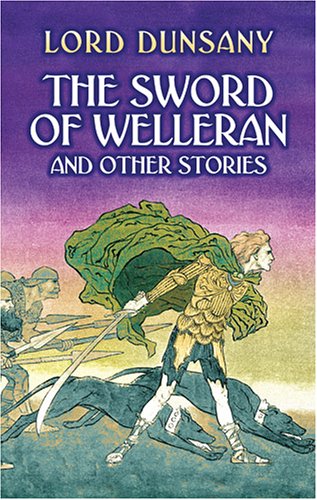 The Sword of Welleran and Other Stories is the influential third book by Irish fantasy writer Lord Dunsany, aka. Edward J. M. D. Plunkett. Dunsany’s stories have been major influences on the work of J. R. R. Tolkien, H. P. Lovecraft, Ursula LeGuin and many others writing fantasy today. This collection of stories was first published in hardcover by George Allen & Sons in October, 1908, and has been reprinted a number of times since.
The Sword of Welleran and Other Stories is the influential third book by Irish fantasy writer Lord Dunsany, aka. Edward J. M. D. Plunkett. Dunsany’s stories have been major influences on the work of J. R. R. Tolkien, H. P. Lovecraft, Ursula LeGuin and many others writing fantasy today. This collection of stories was first published in hardcover by George Allen & Sons in October, 1908, and has been reprinted a number of times since.
Some of the short stories in this collection are linked by Dunsany’s invented pantheon of deities who dwell in Pegāna, which were the focus of his earlier collections The Gods of Pegāna and Time and the Gods. One of the stories, “The Fortress Unvanquishable, Save for Sacnoth,” was afterwards (1910) published by itself as a separate book, a now very-rare “Art-and-Craft” style limited edition. A scene from “The Highwaymen” is very similar to a scene I’d written a few weeks back in one of my Proppian adventures.
To me Dunsany is a true master of the fantastic form. His collection, The Hashish Man has been a major influence on my writing and my own thinking about creating interesting characters in role playing games since I first read it back in 2000. This heightened imagination continues to inspire me to this day.
This collection is well worth finding at a used book store for $2 (thanks, Half Price Books!), but also available for free online at Project Gutenberg. Check it out for inspiration in your fantasy role playing games.
Posted in Uncategorized and tagged fiction, inspiration by Stephen Hilderbrand with no comments yet.
Memory Eater
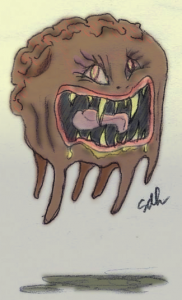 This floating, mostly-mandible creature eats memories, dealing XP damage rather than normal damage. Watch out for crits!
This floating, mostly-mandible creature eats memories, dealing XP damage rather than normal damage. Watch out for crits!
Memory Eater
Size/Type: Small Aberration (Evil, Psionic)
Hit Dice: 8d8+15 (50 hp)
Initiative: +7
Speed: fly 60 ft. (12 squares)
Armor Class: 24 (+1 size, +6 Dex, +7 natural), touch 17, flat-footed 18
Base Attack/Grapple: +6/+3
Attack: Bite +8 melee (1d3+1)
Full Attack: Double bite +8 melee (1d3+1)
Space/Reach: 5 ft./5 ft.
Special Attacks: Psi-like abilities, steal memory
Special Qualities: Blindsight 60 ft., damage reduction 10/adamantine, immunity to fire, power resistance 23, resistance to electricity 15, vulnerability to protection from evil, shift alignment
Saves: Fort +4, Ref +7, Will +8
Abilities: Str 15, Dex 23, Con 15, Int 12, Wis 16, Cha 14
Skills: Bluff +15, Concentration +11, Hide +16, Listen +16, Move Silently +16
Feats: Combat Manifestation, Toughness, Up the Walls, Wild TalentB
Environment: Underground
Organization: Solitary or pod (2-4)
Challenge Rating: 8
Treasure: standard coins of various sorts; double goods; standard items
Alignment: Always chaotic
Advancement: 9-12 HD (Medium), 13-16 (Large)
Level Adjustment: +7
Memory eaters understand common and all the tongues of the Dream and Astral Planes, and can understand any of the languages of prey whose memories they have stolen.
Combat
Steal Memory (Su): Upon a successful critical hit (range 18-20) on a creature, memory eaters steal memories from the creature, dealing 5d20 xp damage. Exactly which memories are taken is up to the DM. If the memory eater is killed, the memory is split among the party, who all feel as if they have the memory all to themselves. The XP taken is also split back among the party.
Psi-Like Abilities
Like their rival yet much smaller brethren, intellect devourers, memory eaters have supernatural mental abilities, including: at will—cloud mind, compression, detect psionics, ego whip (2d4, DC 16*), empty mind (+5 on Will saves*), id insinuation (three targets, DC 16*); 3/day—body adjustment (2d12*), intellect fortress, painful strike. Manifester level 7th.
The save DCs are Charisma-based.
*Includes augmentation for the memory eater’s manifester level.
Blindsight (Ex): A memory eater can use nonvisual means to ascertain all foes within 60 feet as a sighted creature would.
Alignment Shift (Ex): Memory eaters’ alignments shift based on the experiences they have experienced second-hand.
Skills
Memory eaters have a +4 racial bonus on Bluff checks. They also have a +8 racial bonus on Move Silently checks and Listen checks. Finally, they enjoy a +8 on all Knowledge checks, since they have learned more than their physical bodies have experienced.
Posted in Creature by Stephen Hilderbrand with no comments yet.
Issue 17 Released!
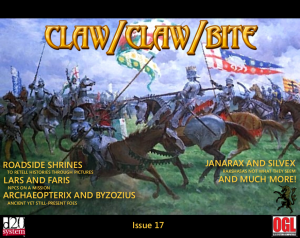 As you know, Claw/Claw/Bite is a magazine devoted to developing new material for Pathfinder and d20 system role playing games.
As you know, Claw/Claw/Bite is a magazine devoted to developing new material for Pathfinder and d20 system role playing games.
This issue of Claw/Claw/Bite includes the following:
Note the new landcape design, complete with 3-column presentation.
Buy the new issue at rpgnow, or if you simply must have it for free for review purposes, email us at clawclawbite AT gmail DOT com.
Posted in Uncategorized and tagged CCB issue, release by Stephen Hilderbrand with no comments yet.
DnFnD #1 – Bards
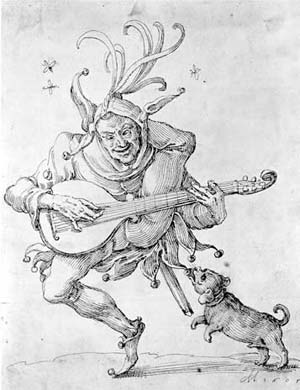 Bards are the quintessential fantasy role playing characters. They are the ones who tell the stories. They write the songs that make the XP ring. In a way, the players playing DnFnD are bards.
Bards are the quintessential fantasy role playing characters. They are the ones who tell the stories. They write the songs that make the XP ring. In a way, the players playing DnFnD are bards.
I’m not suggesting you sing at your games, but you know what I mean. And why rule singing out? It’s a heck of a way to liven up a session. Not recommended in apartment complexes with thin walls…
As stated in Appendix II of the PHB, in 1st Edition DnFnD, …
Read the rest of the article here.
Posted in 1st edition D&D, Editorial and tagged dnfnd by Stephen Hilderbrand with no comments yet.
Statue of Limitations
 Each statue of limitations appears to be a humanoid statue between eight and twelve inches, with one feature diminished in size. These features correspond with which stat attribute they limit to a highest value of 14. Greater statues of limitations limit these values to 10, lesser to 18.
Each statue of limitations appears to be a humanoid statue between eight and twelve inches, with one feature diminished in size. These features correspond with which stat attribute they limit to a highest value of 14. Greater statues of limitations limit these values to 10, lesser to 18.
When the figurine is worn around one’s neck, its effects radiate 5′ in all directions, affecting others.
If a statue of limitations is broken or destroyed, its effects are nullified, its power departed.
Each feature on the statue that appears diminished on the statue is so limited. Figurines with all six attributes limited appear with all six features diminished.
Price: 8,000gp, lesser 4,000gp, greater 16,000gp.
Posted in Magic Item and tagged cursed, necklace, statue by Stephen Hilderbrand with no comments yet.
Map Pins
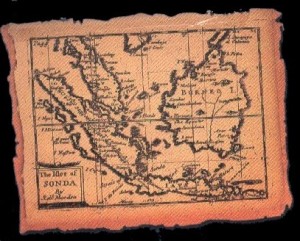 This campaign flavor is also a nice trap, or in the modern parlance, a hazard. Have a map available on a desk or pinned to a wall in a mage’s tower, with a map pin corresponding to the current location. As the characters remove the pins and place them in new locations, the tower teleports them to the new location.
This campaign flavor is also a nice trap, or in the modern parlance, a hazard. Have a map available on a desk or pinned to a wall in a mage’s tower, with a map pin corresponding to the current location. As the characters remove the pins and place them in new locations, the tower teleports them to the new location.
See how this can be used in various forms and in various environments, for instance representing the location of a large floating disk in a catacomb riddled with pit traps. The party will have to play with the pins on their confusing map (where are they, for instance?) until they find which one will bring them the disk. Meanwhile, other pins correspond to beholders and other nasty creatures, which the party inadvertently teleports in in their search for the disk.
Posted in Magic Item, Trap and tagged campaign flavor, hazard, map by Stephen Hilderbrand with no comments yet.
Cut-up Construct
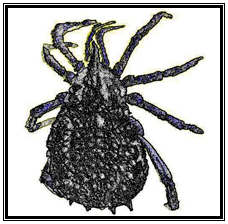 Cut-ups are magically created automatons of varying power. Constructing one involves a decoupaged collage of scroll parchment and the employment of summoning magic, which pulls together the components for the Cut-up out of the ether. The tasks to be performed by the Cut-up must be written along the edge of the collage in a magical runic script. This is usually done in chalk so the collage may be reused.
Cut-ups are magically created automatons of varying power. Constructing one involves a decoupaged collage of scroll parchment and the employment of summoning magic, which pulls together the components for the Cut-up out of the ether. The tasks to be performed by the Cut-up must be written along the edge of the collage in a magical runic script. This is usually done in chalk so the collage may be reused.
The animating force for a Cut-up is a spirit from the Ethereal Plane. The process of creating the Cut-up assembles the component corporeal matter and breathes a temporary life into them, subjecting the ethereal spirit to the Cut-up’s creator, at least until their servitude is complete, as dictated by the tasks set forth in runes.
Combat
Since they are collections of multiple life forces all bent on competing their tasks and thus being set free, Cut-ups are strong-willed and tenacious in combat. They make any and all decisions based on this drive for freedom. They follow instructions explicitly and are incapable of any strategy or tactics outside this fundamental urge. For this reason, some may even attack their creators, if their creators are not careful to make their tasks clear.
Fatal Flaw
Cut-ups are destroyed if the collage used to summon them is destroyed, whether by fire, evisceration, or even a simple tear down the center of the parchment. Creators of Cut-ups must thus stow their collages with care, especially if they intend to reuse them.
Construction
The cost to create each Cut-up includes the cost of the scroll parchment used to breathe life into the collages and a bag of holding to provide the link the Ethereal Plane. Completing the Cut-up’s creation drains 50 XP from the creator. The bag of holding is not consumed in the creation, and once the Cut-up returns to the Ethereal Plane, the bag is left on the ground.
The resulting Cut-up can be up to 1’x1’ per level of the spellcaster. For instance, Mialee, a 14th-level spellcaster, creates a collage, and summons the ethereal energy to manifest a Cut-up up to 14’x14’. This creature is included in the stat block below.
The physical characteristics of a Cut-up come from its design on parchment, so there is infinite variation in their final forms.
Mialee’s Cut-up
Size/Type: Large Construct
Hit Dice: 14d10+30 (105 hp)
Initiative: 0
Speed: 30 ft.
Armor Class: 23 (-1 size, 0 Dex, +14 natural)
Base Attack/Grapple: +8/+19
Attack: Slam +14 melee (2d8+8 plus deep cut)
Full Attack: 2 slams +14 melee (2d8+8 plus deep cut)
Space/Reach: 10 ft./10 ft.
Special Attacks: Deep cut
Special Qualities: Construct traits, fatal flaw, flip sides, fold space, damage reduction 10/bludgeoning and piercing, darkvision 60 ft., immunity to magic, low-light vision
Saves: Fort +5, Ref +2, Will +5
Abilities: Str 27, Dex 11, Con Ø, Int Ø, Wis 11, Cha 1
Skills: —
Feats: —
Environment: Any
Organization: Solitary or gang (2-4), up to ¼ the level of the caster
Challenge Rating: 11
Treasure: None
Alignment: Always neutral
Advancement: 15-21 HD (Huge)
Level Adjustment: —
Cut-ups take the forms depicted on their collages.
A Cut-up cannot speak or make any vocal noise. It moves with a wide gait like the folding of paper. It appears weightless, yet is strangely corporeal.
Combat
Flip Sides (Ex): Every round a Cut-up is in combat, there is a 5% chance each round that it will determine that the easiest path to setting its ethereal energy free is to flip sides, turning on its creator. While fighting against its creator, there is a 5% chance that the Cut-up will return to its creator’s side.
Deep Cut (Ex): Since Cut-ups are made of pure ethereal energy, damage dealt by a Cut-up doesn’t heal naturally and resists healing spells. A character attempting to cast a healing spell on a creature damaged by a Cut-up must succeed on a DC 10+ the constructor’s caster level check, or the spell has no effect on the injured character.
Vulnerable to Blades (Ex): Cut-ups are especially susceptible to damage from slashing weapons, which deal double damage.
Immunity to Magic (Ex): A Cut-up is immune to any spell or spell-like ability that allows spell resistance. In addition, certain spells and effects function differently against the creature, as noted below.
A blade barrier spell or other non-magical blade slows the Cut-up (as the slow spell) for 1d6 rounds and deals 2d6 points of damage.
Fold Space (Su): At will, Cut-ups can take shortcuts through the Prime Material Plane by folding themselves through the ether as per the spell ethereal jaunt.
CL 11th; Craft Construct, animate objects, resurrection, caster must be at least 11th level; Price 5,000gp in fine scroll parchment, a bag of holding; Cost 21,500gp, 1,540xp.
Posted in Creature and tagged construct by Stephen Hilderbrand with no comments yet.
Blessed Structures
 In some regions of Proppia, it is rumored that the buildings themselves are touched by a powerful force.
In some regions of Proppia, it is rumored that the buildings themselves are touched by a powerful force.
In order to bless a structure, a 4th level spell, bless structure must be cast with the appropriate magical material component to provide the base bonus.
The effects of these enchantments are due to magical amulets and ward statues mortared within the structures themselves. These bonuses can come in many forms, including strength, AC, saves, temporary hit points, etc.
A common recipient of these blessings are walls, which add bonuses to all those on defense within the walls. This is a great way to achieve mass effects upon entire forces.
Blessings placed in structures are nullified if removed from the structures themselves, for instance if excavated. In these situations, the amulets, statues and other magical items which provided the wards often retain their bonuses, but travel with their new owners. In order for them to bless a new structure, they must be used as material components in the new bless structure invocation.
Posted in Uncategorized and tagged campaign flavor, Location by Stephen Hilderbrand with no comments yet.
Bless Structure
Bless Structure
Enchantment
Level: Cleric 4, Paladin 5
Components: V, S, M
Casting time: 10 minutes
Range: Medium
Target: Structure that the material component is within
Duration: 10 min./level
Saving Throw: None
Spell Resistance: No
This enchantment adds a bonus to all creatures within a structure who side with the caster. The structure is treated as having an enhancement bonus of the type of the alignment of the caster. In addition, those on the side of the caster receive additional bonuses depending on the magical item used in the casting of the spell.
See here for more.
Posted in Uncategorized and tagged cleric spell, cleric spell level 4, paladin spell, paladin spell level 5 by Stephen Hilderbrand with no comments yet.